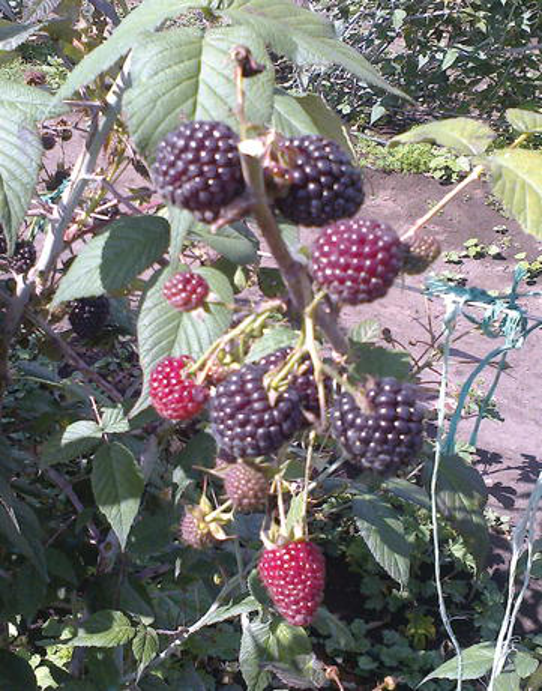May 12, 2025 at 4:13 pm | Updated May 12, 2025 at 4:13 pm | 7 min read
- Color is the chief harvest maturity index.
- Other appearance parameters, such as firmness, size, and weight, are also used.
- Chemical harvest maturity indices, especially the latter, are crucial, including total soluble solids (sugar content), titrable acidity, and taste.
- Blackberries for processing require different harvest maturity indices and increasingly use dry matter.
Harvest maturity indices are essential for all fruit but are critical for non-climacteric fruits like blackberries, harvested at advanced stages of maturity when they are susceptible to damage. Hence, evaluating the correct maturity or ripeness will determine blackberries’ quality and shelf life. Find out which harvest maturity indices are the best for blackberries.
Typical Blackberry Harvest Conditions

Figure 1.: “Fruit of blackberries showing different maturity stages., Horvitz (2016). ( Image credits: https://www.intechopen.com/chapters/55546)
Subscribe to the Felix instruments Weekly article series.
By submitting this form, you are consenting to receive marketing emails from: . You can revoke your consent to receive emails at any time by using the SafeUnsubscribe® link, found at the bottom of every email. Emails are serviced by Constant Contact
Blackberries (Rubus glaucus) are rich in flavonoids and anthocyanins that are nutraceuticals and also responsible for the fruit color. Blackberries are aggregate fruits and lack a protective peel, which leads to rapid water loss, mechanical damage, and fungal decay that shortens postharvest shelf life. As blackberries are non-climacteric, they do not ripen after harvest. Some cultivars change skin color, but other qualities, like sweetness or taste development, don’t occur. Therefore, when the fruits are soft, blackberries are harvested close to full maturity, increasing the chances of damage and decay. Care must be taken not to harvest late when fruits are over-ripe to extend shelf life.
Blackberries do not ripen at the same time, and repeated harvests will be necessary (see Figure 1). Temperature is also crucial for blackberry shelf life, and they are picked in the early morning or evening when the fruit temperature is lower.
Various maturity indices are used to fix berries’ optimum harvest time. The purpose of fruit, such as fresh consumption or processing, can determine the quality parameter used as the harvest maturity index.
Chronological Harvest Maturity Index
Blackberry cultivars mature at different times based on early, mid, or late-season types. Three to six harvests are necessary for a season at intervals of 3-6 days. Growers can follow suppliers’ information or harvest dates from previous years to guide picking timing.
Physical Harvest Maturity Indices
External physical quality parameters can indicate blackberry maturity. These attributes are fruit color, weight, size, ease of detachment, and firmness.
Color
Fruit surface color is mainly used as the harvest maturity index since customers also use this quality parameter to judge blackberries. The fruits must be completely dark purple or black, as color changes rapidly with maturity for all Ecuadorian cultivars, as shown in Figure 2.
Growers in the USA are advised to harvest blackberries when the fruits are shiny for shipping and distant markets. For local sales, growers can wait until the blackberries are dull-colored to allow for better sweetness and taste.
Color is determined with charts or by infrared-red spectroscopy. While color is chiefly used, other parameters that distinguish its various attributes, such as the harvest maturity index, can also be helpful.

Figure 2: “Photographs of blackberry (Rubus glaucus Benth) cultivars from Ecuador in different stages of maturity: (a) Blackberry Castilla variety, (b) Blackberry INIAP Andimora-2013 variety, (c) Blackberry Colombiana variety, and (d) Blackberry Brazos variety,” Samanieg et al. (2020). (Image credits: https://www.mdpi.com/2223-7747/9/8/1027#)
Fruit size and weight
Blackberry cultivars can have a wide range of shapes, sizes, and weights, and pickers must be familiar with the characteristics and features of blackberries being harvested to judge maturity.
- Consider the various shapes, sizes, and weights of 23 blackberry cultivars grown in China, as shown in Table 1.
- Blackberries in Colombia weigh between 5.07 and 9.06 g.
Table 1: “Differences in fruit appearance among 23 blackberry cultivars and strains in China,” Zhao et al. (2023). (Credits: https://doi.org/10.3390/plants12162982)

Firmness
Customers seek blackberries with a firm and crisp texture. Genotypes/cultivars and the external environment determine firmness. Dry and well-lit conditions support the development of firmer and tastier fruits.
- As shown in Table 1, firmness measured as hardness in China varies between 1.13 and 2.78 hardness/kg/cm3 in 23 blackberry cultivars.
- In Colombia, firmness varies between 03 and 4.1 kgf depending on the variety.
Ease of detachment
Ripe blackberries that can be plucked easily without tugging or pulling are considered to be fully mature and suitable for fresh consumption. In large-scale production, mechanical shakers are used to harvest fruit, which can be more mature and tastier than those plucked by hand, since only fully ripe fruits get harvested by shaking. These ripe fruits have had more time for better quality development; see Table 2 for details.
Table 2. “Effect of method of harvest and mechanical shaker frequency on quality of ‘Raven’ blackberries, 1964,” Morris et al. (1978). (Credits: DOI:10.21273/HORTSCI.13.3.228)

Chemical Harvest Indices
The chemical harvest indices are internal parameters such as total soluble solids (TSS), titratable acidity (TA), dry matter, and taste. As fruits mature, the TSS and taste increase, and TA decreases; see Table 3 for changes in Andean blackberries. Non-destructive infrared spectroscopy can measure TSS and TA and calculate taste later. The berries do not have to be picked for sampling so that growers can track the fruits’ maturity pre-harvest without loss of harvest.
The concentration of flavonoids and anthocyanins is the highest at 25% maturity, but the blackberries are not ready for consumption at this early stage. Therefore, this parameter is not used as a harvest maturity index.
Table 3. “Physicochemical analysis of four blackberry cultivars,” Samanieg et al. (2020). (Image credits: https://www.mdpi.com/2223-7747/9/8/1027#)

Total soluble solids
Blackberries must reach ripeness at harvest to be sweet, as TTS doesn’t increase after harvest. Sweetness varies with cultivar and sunlight availability.
- The Ecuadorian standard NTE INEN 2427:2016 has set minimum TSS limits of 9% soluble solids for all Andean commercial blackberries. For specific commercial cultivars, this minimum limit can vary—Castilla must have 9.0°Brix and Brazos 7.0°Brix; see Table 3 for details. The values at 100% maturity are the ideal parameters for use as a harvest maturity index.
- In China, the soluble solids of the TSS vary between 9.20 and 13.15% depending on the variety of 23 blackberry cultivars.
- Colombian blackberries have less TSS in global comparison, and the value varies between 5.68 and 7.55°Brix for ten cultivars.
Titrable acidity
The Ecuadorian standard NTE INEN 2427:2016 sets a maximum titratable acidity for blackberry harvest at 1.8%. Based on cultivars, the Ecuadorian standard requirements are a maximum of 2.70% for Castilla and 2.10% citric acid for Brazos.
- The TA varies between 0.53 and 1.86% in China for 23 blackberry cultivars.
- Colombian blackberries have TA varying from 2.48% to 3.24%; see Table 3 for details.
Taste/ Maturity index
The other primary maturity index (MI) besides fruit color is taste or the ratio of TSS to TA. Among chemical parameters, taste is a better harvest maturity index than sugar or acidity content individually.
- In Colombia, the standard harvest maturity index is 2.2 to 3.1
- For Ecuadorian blackberries, the optimal MI is 3.86 to 6.21.
Harvest Maturity Index for Processing
The important harvest parameters and their values are different for processing, especially juice-making. Processors prefer smaller fruits with less weight for juice-making since they have more juice content. Dry matter can be important for checking the quality of fruits sent for processing in China. Dry matter measures all solid components in fruit, including carbohydrates, proteins, fats, minerals, phenols, etc., minus the water. NIR spectroscopy helps measure dry matter, too.
Table 4: “Differences in fruit processing characteristics among 10 excellent blackberry cultivars and strains,” Zhao et al. (2023). (Credits: https://doi.org/10.3390/plants12162982)

NIR for Blackberry Harvest Maturity Index Measurement
NIR spectrometers are practical for non-destructive measurements of fruit color, TSS, TA, and dry matter, and cover the most widely used harvest maturity indices for blackberry. Felix Instruments Applied Food Science offers the F-750 Produce Quality Meter that can accurately measure all these parameters in real time. The device is small, light, and easy to use and understand. The device supports the development of specific models for blackberries for use in the orchards to improve ROI and fruit supply.
Contact us at Felix Instruments Applied Food Science for information and support about the F-750 Produce Quality Meter.
Sources
Horvitz, S. (2017). Postharvest Handling of Berries. InTech. doi: 10.5772/intechopen.69073
Horvitz, S., Chanaguano, D. and Dugarte, N.Y. (2019). Postharvest quality of a thorny Andean blackberry (Rubus glaucus Benth) cultivar. Acta Hortic. 1256, 47-52
DOI: 10.17660/ActaHortic.2019.1256.7
Morris, J. R., Nelson, G. S., Kattan, A. A., & Cawthon, D. L. (1978). Developing a Mechanized Harvesting and Production System for Erect Blackberries1. HortScience, 13(3), 228-235. Retrieved Apr 16, 2025, from https://doi.org/10.21273/HORTSCI.13.3.228
Perkins-Veazie, P., Fernandez, G., McWhirt, A., & Bradish, C. (n.d.). Harvesting and Postharvest Management. Retrieved from https://content.ces.ncsu.edu/southeast-regional-caneberry-production-guide/harvesting-and-postharvest-management
Samaniego, I., Brito, B., Viera, W., Cabrera, A., Llerena, W., Kannangara, T., Vilcacundo, R., Angós, I., & Carrillo, W. (2020). Influence of the Maturity Stage on the Phytochemical Composition and the Antioxidant Activity of Four Andean Blackberry Cultivars (Rubus glaucus Benth) from Ecuador. Plants, 9(8), 1027. https://doi.org/10.3390/plants9081027.
Sánchez-Betancourt, E., García-Muñoz, M. C., Argüelles-Cárdenas, J., Franco-Flórez, V. and Núñez-Zarantes, V. (2020). Fruit quality attributes of ten Colombian blackberry (Rubus glaucus Benth.) genotypes. Agronomía Colombiana, 38(1), 9–18. https://doi.org/10.15446/agron.colomb.v38n1.80559
Zhao, H., Wu, Y., Wu, W., Li, W., & Jin, Y. (2023). Screening and Evaluation of Excellent Blackberry Cultivars and Strains Based on Nutritional Quality, Antioxidant Properties, and Genetic Diversity. Plants, 12(16), 2982. https://doi.org/10.3390/plants12162982.
Related Products
Most Popular Articles
- Spectrophotometry in 2023
- The Importance of Food Quality Testing
- NIR Applications in Agriculture – Everything…
- The 5 Most Important Parameters in Produce Quality Control
- Melon Fruit: Quality, Production & Physiology
- Fruit Respiration Impact on Fruit Quality
- Guide to Fresh Fruit Quality Control
- Liquid Spectrophotometry & Food Industry Applications
- Ethylene (C2H4) – Ripening, Crops & Agriculture
- Active Packaging: What it is and why it’s important






